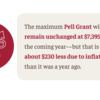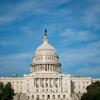Last week, Congress finally reached a deal to fund the federal government through the rest of the fiscal year. After a ridiculously dramatic year, which included the unprecedented mid-year ousting of a Speaker of the House, the “appropriations” process has now ended. The funding deal for FY 2024 keeps the lights on for federal agencies through September 30th.
Unusually, the deal to fund the government for the current fiscal year came after the Biden Administration had already released its budget for the next fiscal year, which contains a number of proposed investments in students. Unlike the President’s proposals, the news for college students in the FY24 deal passed last week isn’t great—but it could have been much worse.
While higher education was thankfully spared some of the more egregious cuts that the House majority had proposed, the truth is that we need far greater investment in order to reverse the crises of basic needs insecurity, college affordability, and other growing challenges like campus mental health.
Throughout this long and tumultuous process, decisions about federal student aid, competitive grant programs, and public benefits have all been on the line. The back-and-forth over spending has included fights about the debt ceiling, proposals to eviscerate domestic investments, and rising acrimony between Congress and the White House. As expected, the final $1.2 trillion package largely treads water by level funding programs that impact college affordability and student basic needs.
In this political environment—with the House majority having advanced proposals that would slash education funding—the flat funding averts some of the worst potential outcomes. But students have been languishing in the land of “low expectations” for far too long. The Hope Center praised Congress for adopting higher investments in student basic needs for FY23 while calling out areas that could have been better. We tried to take a balanced perspective in reacting to the President’s FY24 budget request but kept pushing on Congress to increase investments in programs that support students’ urgent needs for affordable food, housing, child care, health care, transportation, and more. After all, more than 4.3 million students don’t have enough to eat.
Unfortunately, since then, Congress and the White House agreed to impose arbitrary caps on the funding that can support “nondefense” programs like education, nutrition, and health. The Fiscal Responsibility Act of 2023 sharply limited any new investments through at least Fiscal Year 2025. These budget caps don’t allow federal investments to keep pace with inflation (typically 3-4% per year), meaning that this flat funding is a cut in real dollars. For example, the maximum Pell Grant will remain unchanged at $7,395 for the coming year—but that is worth about $230 less due to inflation than it was a year ago.

In addition, Congress decided against funding the crucial Affordable Connectivity Program (ACP), which helps low-income households (including Pell Grant recipients) afford broadband internet. Between flat funding of financial aid and the elimination of ACP, even students who get the same amount of financial aid this year will be worse off. Below, we break down the notable decisions.
Grants to Colleges
The agreement provided level funding for several grant programs that help colleges develop and expand interventions to address basic needs. Specifically, the bill provides $10 million for the Basic Needs for Postsecondary Students Program(“Basic Needs Grants”), the same as last year. While several other grant programs dwarf the funding for this critical program, and it is nowhere near the level needed to address the crisis of student basic needs insecurity, negotiators were able to prevent a 50% cut to the program proposed by the House majority. In addition, the funding deal refers to language included by the House in a previous bill, which helps focus the program on promising, evidence-based activities like connecting students with public and tax benefits and surveying students about their basic needs.
The bill also maintains $75 million for the Child Care Access Means Parents in School (CCAMPIS) program, which helps provide accessible and affordable child care for the one in five undergraduates—and one in three graduate students—in the United States who are parents of dependent children. This program currently provides grants to over 250 institutions. Still, the House majority had proposed eliminating CCAMPIS despite the declining availability of on-campus child care centers and the rapidly increasing cost of child care. Given the need, The Hope Center joined 55 other organizations calling on Congress to increase CCAMPIS funding to $500 million. Unfortunately, CCAMPIS did not receive a commensurate boost as other child care programs in the bill (more below).
The funding deal also maintains funding for the Postsecondary Student Success Grants (PSSG) program at $45 million, which colleges can use to fund evidence-based interventions to reduce student basic needs insecurity and increase student retention and completion (such as CUNY ASAP and other CASS programs that include emergency aid and support for child care, textbooks, transportation, ad more). The bill also reduced the funding for the Open Textbooks Pilot Program—which helps colleges develop free course materials for their students—to $7 million (down from $12 million in FY23).
Unfortunately, the funding agreement also flat funds the Garrett Lee Smith (GLS) Campus Suicide Prevention Grants at just $8.48 million, a paltry sum relative to the large and growing crisis of campus mental health. Despite proposals in recent years to address college mental health, GLS remains the only federal program dedicated to supporting mental health needs in higher education. Elsewhere, broader mental health and school-based K-12 mental health programs received a nearly $75 million boost, but these programs unfairly exclude colleges and students in higher education. In addition, the funding deal does little to address some of the shortcomings in the GLS program, including matching requirements and an incomplete link between material basic needs insecurity and mental health challenges.
Bottom line—colleges will maintain access to a suite of competitive grant programs now totaling more than $100 million per year (excluding PSSG) that directly impact student basic needs and non-tuition costs like food, housing, child care, textbooks, and mental health. But the demand for these services vastly exceeds the funding provided, and policymakers should work to better coordinate these programs.
Financial Aid for Students
The funding deal maintains the maximum Pell Grant award of $7,395 for the 2024-2025 award year. However, level funding for the Pell Grant will further erode its purchasing power, which is already at a historically low level given rising college costs: currently, the maximum grant covers just a quarter of the cost of attending a public 4-year college ($28,840), and only about a third of the cost of attending a community college ($19,860). As mentioned, the maximum award is currently worth about $230 less than it was a year ago due to inflation, meaning students will have to stretch the same limited dollars even further to afford their tuition and basic needs.
Overall, the Pell Grant program is facing a looming shortfall, which could occur as early as Fiscal Year 2025 (more information will be released in June when the Congressional Budget Office updates its annual “baseline”). The funding deal only provided the same amount of discretionary funding to the Pell Grant as Congress did last year, so conversations on this cornerstone of financial aid will soon be heating up.
Budget projections indicate that recovering college enrollment, higher discretionary maximum awards, and eligibility improvements have combined to increase the cost of the Pell Grant program. Because the program has become more expensive, it will soon face a funding gap without new funding. Less than a decade ago, a Pell Grant shortfall resulted in damaging eligibility cuts when Congress decided to cut vulnerable students out of the program, rather than add substantial new funding or reduce the maximum award level.
On the positive side, Congress did not raid the dwindling surplus funds of the Pell Grant this time. Appropriations deals have sometimes taken money from the Pell Grant reserve—like a “rainy day” fund—to spend on other priorities. For example, since 2017, Congress has removed more than $4.8 billion from the Pell Grant’s surplus. These short-sighted decisions will soon catch up with policymakers who will soon need to add money back into the program to avert damaging cuts. Congress should make the program fully mandatory, just like federal student loans and Social Security.
The campus-based aid programs, Federal Work Study (FWS), and the Supplemental Educational Opportunity Grant (SEOG) were also flat-funded, at $1.23 billion and $910 million, respectively. Campus-based aid can be leveraged to address basic needs, as students receiving FWS can qualify for food assistance under the Supplemental Nutrition Assistance Program (SNAP) without having to meet additional onerous work requirements.
Additionally, during the pandemic, SEOG was permitted to function as emergency aid for students. While Congress did not restore this flexibility in this bill, it should do so next year. SEOG can provide a robust and long-term source of funding for emergency aid, which students overwhelmingly use to cover their basic needs. Like the Pell Grant, it is critical for Congress to ensure that the “purchasing power” of campus-based aid keeps pace with inflation when they allocate funding—and it is unfortunate they did not do so this year.
Lastly, the bill provided a small $25 million (1.2%) bump to the account that helps the U.S. Department of Education run the financial aid programs—known as “Student Aid Administration.” This funding has received additional scrutiny as the agency has struggled to implement the major overhaul of financial aid under the FAFSA Simplification Act, resulting in numerous delays and errors in the calculation of aid. In providing the Department with Student Aid Administration funds this year, Congress directed the agency to provide updates on how they are “working with institutions of higher education (IHEs) and States to mitigate the impacts of the 2024-2025 FAFSA delay on students and families.” Still, this year’s allocation is nearly $600 million below what the agency requested. Much more may be needed to ensure the FAFSA overhaul can get back on track.
Public Benefits
In a tragic and short-sighted move, Congress failed to provide additional funding for the Affordable Connectivity Program which, absent a last-minute saving, will run out of funding next month. The 23 million low-income people who receive ACP discounts—including many Pell Grant recipients—get $30 per month off their broadband bill, and often free internet altogether. The Hope Center recently joined over 70 organizations calling on Congress to fund ACP. We remain hopeful that Congress will act swiftly to avoid disaster.
In one of the rare bright spots, child care did receive more than $1 billion in new funding through a $725 million (or 9%) increase to the Child Care and Development Block Grant (CCDBG) and a $275 million increase to Head Start. Recently, several community colleges have established promising partnerships with Head Start to support their parenting students through the “Kids on Campus” initiative, led by the Association of Community College Trustees (ACCT) and National Head Start Association (NHSA). Hopefully, students will be able to benefit from some of the CCDBG and Head Start funding increases, but it is essential for Congress to also invest in CCAMPIS to support parenting students directly.
In the first part of the spending package approved a few weeks ago, which funded the U.S. Department of Agriculture, Congress also secured more than $1 billion in new funding to fully fund the Special Supplemental Nutrition Program for Women, Infants, and Children (WIC) program—which serves nearly 7 million women and kids nationwide—including many parenting students.
The portion of that bill that funds the U.S. Housing and Urban Development (HUD) programs maintains a longstanding and damaging policy rider that bans students from receiving “section 8” housing assistance to support their basic needs. Congress must dump this damaging and short-sighted rider, which harms student basic needs security and the economic mobility of the recipients of HUD assistance.
Earmarks for Basic Needs
Members of Congress have funded a wide array of community projects, also known as “earmarks” or “Congressionally directed spending,” many of which support students’ basic needs through institutions of higher education and non-profit organizations. Last year, Congress sent more than $1.7 billion to 550 colleges and universities in total.
Across both FY24 funding packages, we identified at least 14 notable earmarks that relate directly to student basic needs totaling more than $15 million, including:
Departments Of Labor, Health and Human Services, and Education, and Related Agencies
- $500,000 for the Milwaukee Area Technical College FAST Fund delivering emergency grants for students’ basic needs (Sen. Baldwin)
- $1,500,000 for the Board of Trustees of the University of Illinois, IL, for school-based mental health services, including equipment (Sen. Durbin)
- $2,557,000 for Mississippi State University, MS, for mental and behavioral health services (Sen. Hyde-Smith)
- $250,000 for Nazareth College of Rochester, NY, for mental health care, including therapy and wellness services for underserved children and adults (Sens. Gillibrand, Schumer)
- $80,000 for West Liberty University, WV, for a therapy and counseling program (Sen. Manchin)
Department of Agriculture
- $1,750,000 for the Alpena Community College Alpena Community College for Student Housing Community Facility (Sen. Peters/Stabenow)
Department of Housing and Urban Development
- $1,000,000 for the Long Beach City College for Student Housing and Higher Education Complex (Rep. Barragan)
- $2,000,000 for the Auraria Higher Education Center for the Auraria Early Learning Center (Sen. Bennett, Hickenlooper)
- $1,466,279 for the San Diego Community College District Family-Friendly Study Center (Rep. Jacobs)
- $1,666,279 for Cabrillo Community College District for the Cabrillo Child Care Center (Rep. Panetta)
- $1,000,000 for the Cerritos College Cerritos Community College Child Development Center (Rep. Sanchez)
- $500,000 for Richland Community College for EnRich Educational Campus Housing. (Rep. Budzinski)
- $620,000 for the Durham Technical Community College Foundation, Inc. for the Durham Tech Affordable Housing Initiative (Rep. Foushee)
- $800,000 for Raise the Barr for Affordable Housing for Single-Parent Students and Their Children (Rep. Barragan)
Conclusion
In the end, FY24 funding levels for the programs that affect student basic needs and college affordability were mostly the same as they were in FY23. However, damaging cuts were avoided, and some new decisions could benefit students in the margins. Given that there was progress in last year’s funding deal, it is positive that Congress did not erode those advances despite the divisiveness of this year’s appropriations battles.
Still, failing to increase financial aid and public benefits with inflation will mean that students and their families will face higher costs; any allocated supports simply won’t go as far. Congress needs to dump arbitrary budget caps, invest in education and health programs, and meet students’ basic needs so they can succeed in college and the workforce.
We’ll have more to say on the upcoming budget and appropriations cycle in just a few weeks. Stay tuned.



